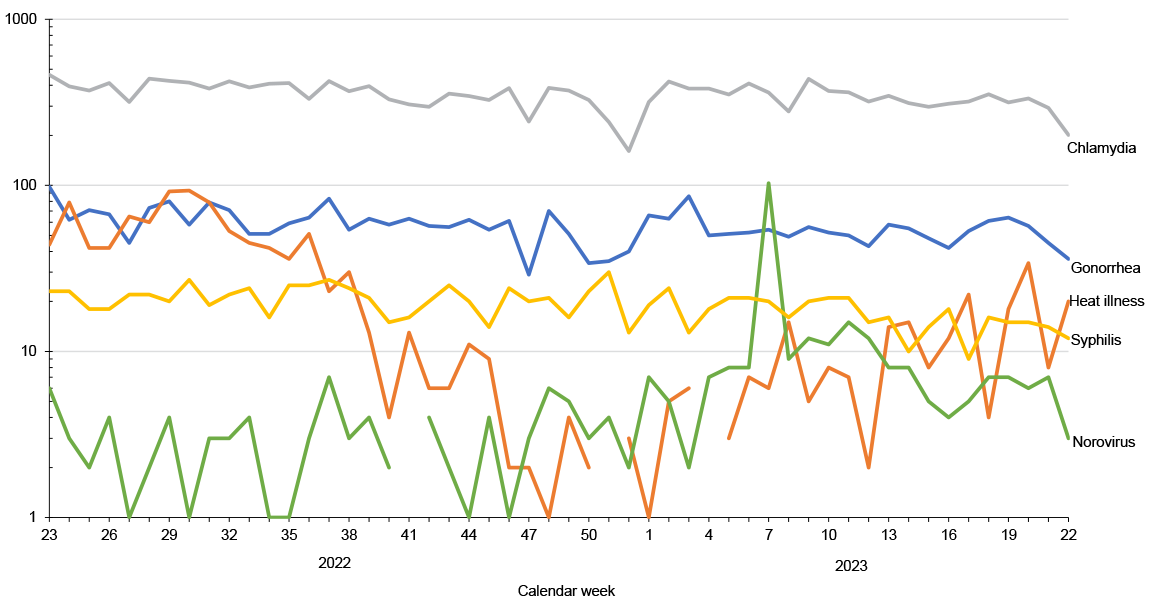Reportable Medical Events, Military Health System Facilities, Week 22, Ending June 3, 2023
 Graph depicting the frequency of the five most common reportable medical events within the Military Health System over the preceding year.
Graph depicting the frequency of the five most common reportable medical events within the Military Health System over the preceding year.
Reportable Medical Events are documented in the Disease Reporting System internet by health care providers and public health officials across the Military Health System for the purpose of monitoring, controlling, and preventing the occurrence and spread of diseases of public health interest or readiness importance. These reports are reviewed by each service’s public health surveillance hub. The DRSi collects reports on over 70 different RMEs, including infectious and non-infectious conditions, outbreak reports, STI risk surveys, and tuberculosis contact investigation reports. A complete list of RMEs is available in the 2022 Armed Forces Reportable Medical Events Guidelines and Case Definitions.1 Data reported in these tables are considered provisional and do not represent conclusive evidence until case reports are fully validated.

Total active component cases reported per week are displayed for the top five RMEs for the previous year. Each month, the graph is updated with the top five RMEs, and is presented with the current month’s (May 2023) top five RMEs, which may differ from previous months. COVID-19 is excluded from these graphs due to changes in reporting/case definition updates in 2023.

References
- Armed Forces Health Surveillance Division. Armed Forces Reportable Medical Events. Accessed April 6, 2023. https://www.health.mil/Military-Health-Topics/Health-Readiness/AFHSD/Reports-and-Publications/Armed-Forces-Reportable-Medical-Events
- Defense Manpower Data Center. Department of Defense Active Duty Military Personnel by Rank/Grade of Service, October 31, 2022. https://dwp.dmdc.osd.mil/dwp/app/dod-data-reports/workforce-reports
- Defense Manpower Data Center. Armed Forces Strength Figures for January 31, 2023. https://dwp.dmdc.osd.mil/dwp/app/dod-data-reports/workforce-reports
- Navy Medicine. Surveillance and Reporting Tools–DRSI: Disease Reporting System Internet. https://www.med.navy.mil/Navy-Marine-Corps-Public-Health-Center/Preventive-Medicine/Program-and-Policy-Support/Disease-Surveillance/DRSI
You also may be interested in...
Article
Apr 1, 2024
Since 2001, MSMR has published regular reports on the incidence of heat illness among U.S. active component service members. This annual update presents summaries of heat stroke and heat exhaustion case counts, incidence rates, and locations from 2019 through 2023.
Article
Mar 27, 2024
Public health officials from across DHA Public Health will host several activities next week in observance of National Public Health Week, April 1–7.
Article
Mar 22, 2024
The World Meteorological Organization, which monitors climate, weather, and water resources for the United Nations, has declared that 2023 was the hottest year in recorded history.
Article
Mar 12, 2024
Public health preparedness and response is a critical area of focus as Defense Public Health transitions some of the military component public health functions to the Defense Health Agency. This includes all-hazard biosurveillance and public health emergency management, or PHEM.
Report
Mar 1, 2024
 .PDF |
1.34 MB
.PDF |
1.34 MB
The March 2024 MSMR features a comparison of 2018 estimates from the HRBS and the PHA on tobacco and nicotine use among the U.S. military active component; followed by a report on coverage of HIV PrEP among active duty service members in 2023; supplemented by a Surveillance Snapshot of HIV PrEP prescriptions in 2023 in the active component; then a ...
Article
Mar 1, 2024
This Surveillance Snapshot provides the number of U.S. military active component service members prescribed HIV pre-exposure prophylaxis medication in 2023.
Article
Mar 1, 2024
Reportable Medical Events are documented in the Disease Reporting System internet by health care providers and public health officials throughout the Military Health System.
Article
Mar 1, 2024
This is an introduction to a composite of three Surveillance Snapshots of Department of Defense data on mid-season influenza vaccine effectiveness that were presented at the 2024 VRBPAC meeting.
Article
Mar 1, 2024
This study compared estimates of the prevalence of and risk factors for tobacco and nicotine use obtained from the 2018 Health Related Behaviors Survey and Periodic Health Assessment survey. The HRBS and the PHA are important Department of Defense sources of data on health behavior collected from U.S. military service members.
Article
Mar 1, 2024
This Surveillance Snapshot presents a comparison of U.S. active component military and general population HIV incidence rates in 2021, the most recent year for which stratified U.S. data were available, using indirect standardization by sex, age, and race and ethnicity.
Article
Mar 1, 2024
This study provides the first estimate of HIV pre-exposure prophylaxis coverage in the U.S. military, defined as the proportion of the persons taking HIV PrEP out of the estimated number of persons who had indications for it, that is also comparable to U.S. civilian estimates. The population with indications for HIV PrEP was obtained from the ...
Article
Mar 1, 2024
This Surveillance Snapshot provides an overview of the 2023-2024 mid-season analysis of influenza vaccine effectiveness against medically-attended ambulatory influenza infections among U.S. military active component service members.
Article
Mar 1, 2024
This Surveillance Snapshot provides influenza vaccine effectiveness estimates against ambulatory influenza among Department of Defense TRICARE beneficiaries.
Article
Mar 1, 2024
This Surveillance Snapshot provides an overview of the 2023-2024 mid-season analysis of influenza vaccine effectiveness against influenza hospitalizations among U.S. military active component service members.
Article
Feb 27, 2024
Many working-age adults in the U.S. spend eight hours per day or more in front of a computer. Screen time can be harmful to your health in more ways than one. Here are some tips and recommendations to help you reduce those risks.
You are leaving Health.mil
The appearance of hyperlinks does not constitute endorsement by the Department of Defense of non-U.S. Government sites or the information, products, or services contained therein. Although the Defense Health Agency may or may not use these sites as additional distribution channels for Department of Defense information, it does not exercise editorial control over all of the information that you may find at these locations. Such links are provided consistent with the stated purpose of this website.
You are leaving Health.mil
View the external links disclaimer.
Last Updated: August 24, 2023